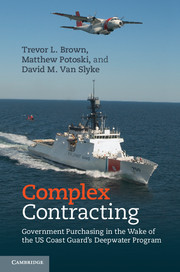Book contents
- Frontmatter
- Contents
- List of figure and tables
- Foreword
- 1 Introduction: the promise and perils of government contracting
- 2 Managing complex contracting in theory and practice
- 3 The Coast Guard’s Deepwater program
- 4 Rules in complex contracts
- 5 Performance incentives in complex contracts
- 6 Complex contracting’s promise and pitfalls: win-win and lose-lose
- 7 Management strategies for complex contracts
- References
- Index
6 - Complex contracting’s promise and pitfalls: win-win and lose-lose
Published online by Cambridge University Press: 05 August 2013
- Frontmatter
- Contents
- List of figure and tables
- Foreword
- 1 Introduction: the promise and perils of government contracting
- 2 Managing complex contracting in theory and practice
- 3 The Coast Guard’s Deepwater program
- 4 Rules in complex contracts
- 5 Performance incentives in complex contracts
- 6 Complex contracting’s promise and pitfalls: win-win and lose-lose
- 7 Management strategies for complex contracts
- References
- Index
Summary
“THE BOAT THAT DON’T FLOAT”
The Tomahawk missile is one of the deadliest combinations of power and precision in the United States’ military arsenal. Launched from a ship or a submarine, a Tomahawk can travel 1,350 nautical miles at 550 miles per hour and can be redirected in flight to pinpoint a target. The missile’s impact often occurs within seconds of launch. During the 2003 invasion of Iraq, the assault on Baghdad commenced with a salvo of Tomahawks from the submarine USS Cheyenne. By the end of the first year of combat, coalition forces had launched over 700 Tomahawks on Iraqi targets (GlobalSecurity.org, n.d.a). The tactical advantage of the Tomahawk is its ability to inflict tremendous damage with minimal risk to the attacker’s forces. Since the Tomahawk is most often deployed from sea, US warships can sit a safe distance from most land-based missile systems and repeatedly pound a target. The primary threat to Tomahawk-equipped warships is not from land, but from much smaller boats at sea. Ships and submarines that launch Tomahawks are big – the USS Cheyenne is over 350-feet long – and are not easy to maneuver. To launch a Tomahawk, a warship needs a stable and secure perimeter. In a combat mission on the scale of Operation Iraqi Freedom in 2003, the Navy needed a lot of smaller agile boats to keep enemy watercraft from penetrating the perimeter, sometimes requiring boats beyond the Navy’s fleet. Enter the US Coast Guard.
The workhorse of the Coast Guard fleet has historically been a class of small ships called cutters which range in size from 80 to just over 100 feet in length. Cutters are highly versatile, big enough to carry a good-sized crew along with a smaller boat or two and deploy to engage a target quickly, like interdicting a drug runner. But cutters are small enough to operate in smaller bodies of water, like inland rivers and lakes. The Coast Guard uses these boats in almost all of its missions, including providing support to the US Navy.
- Type
- Chapter
- Information
- Complex ContractingGovernment Purchasing in the Wake of the US Coast Guard's Deepwater Program, pp. 173 - 202Publisher: Cambridge University PressPrint publication year: 2013



